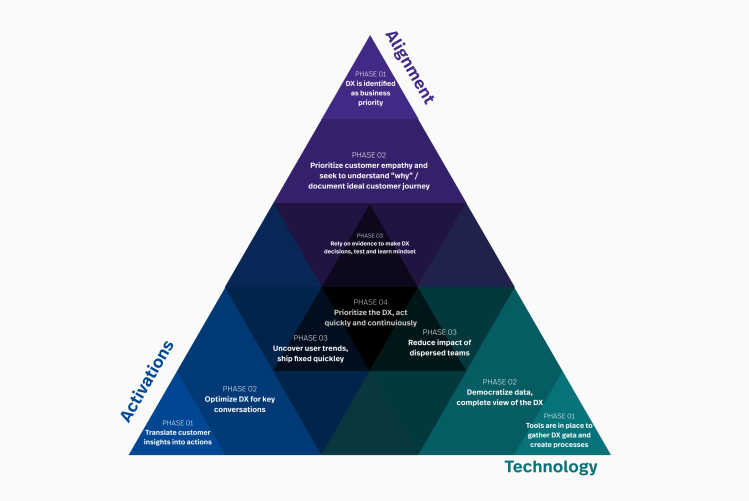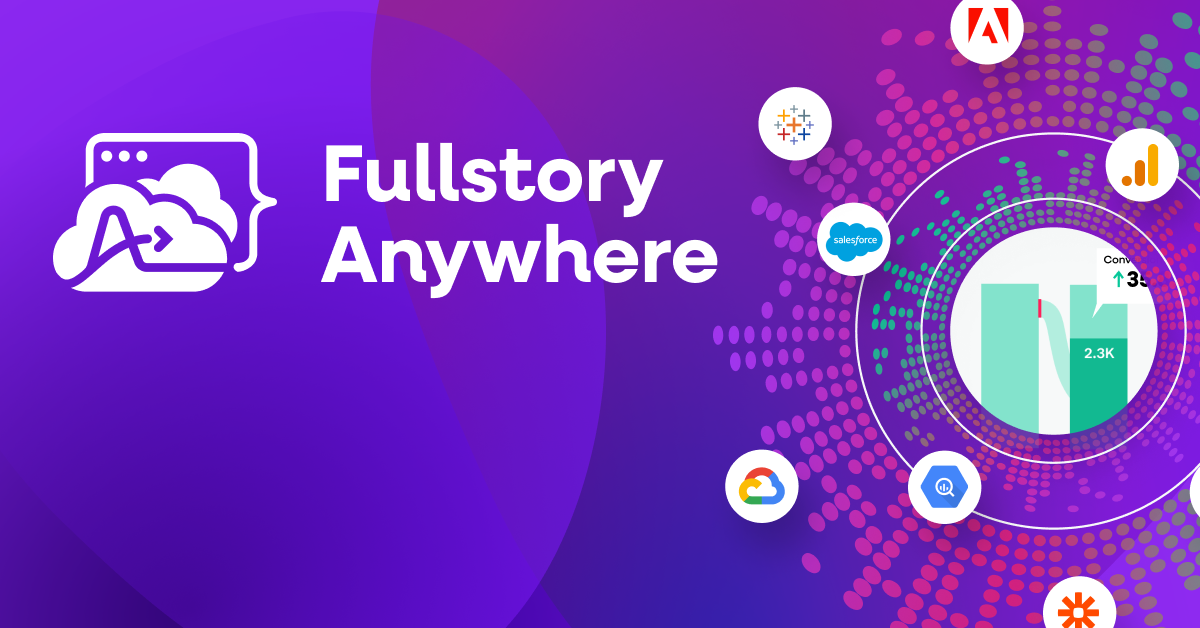According to a Fullstory survey, 55% of consumers surveyed said they wouldn’t return to a business that provides a poor digital experience.
No matter where you are on the road to digital perfection, Digital Experience Intelligence (DXI) can supercharge your understanding of your users, help you build a frictionless product, and allow you to reap revenue growth from it all.
How your organization uses product analytics and DXI might differ based on its digital experience maturity—that is, the ability to apply technology and data to reach the digital outcomes you’re looking for.
Evaluating DX maturity is complex. While there are three key pillars—Alignment, Technology, and Activations—the concept is far more nuanced. For example, an organization might excel in their Alignment, they may fall short on Technology.
If you haven’t already, check out this short guide to digital experience maturity before you continue.
Let’s look at how data and analytics fit into each phase of digital experience maturity, and how you can move your organization to the next level.
Phase 1: Starting serious data collection and strategy building
What this phase looks like:
In this phase, data is often accessible only to those that know where to look. You’re working with data, but chances are you haven’t reached the pixel-perfect visibility into user behavior you need. In addition, current strategies to collect and activate data heavily rely on engineering to instrument what you think is important to track or analyze. This often translates to decisions being handed down from the top of the org, forcing teams to prioritize volume of features over impact. Teams in this phase, for example, might spend a quarter shipping three new features that move the needle incrementally or not at all, rather than using data to choose one feature that will result in dramatically higher conversion rates.
As the line blurs between product analytics and digital experience analytics, you might find yourself using multiple tools with functionality that overlaps. You’re starting to figure out ways to consolidate tools but still find it difficult to tie insights to revenue or retention without a cohesive data set.
What Product Analytics might look like at this phase:
Page flow analysis to increase visibility into how users move through specific areas
Segmentation and basic cohort analysis to identify important customers
Heavy reliance on instrumentation but using some form of autocapture
A dedicated analytics team to validate the quantitative analysis, supplemented by session replay
“Most companies don’t tag everything. Fullstory has been able to fill in some gaps for us, like 404 error pages or product availability, where we did not have them tagged, but we were able to see what was going on and then make adjustments. And it’s millions of dollars that we have saved.” -Stephen Stewart, Senior Manager of Merchandising Analytics at Lowe’s
Your next best actions for phasing up:
Balance out your analytics plan with autocapture that goes further than solely “capture” to structure and index data automatically–with privacy top of mind. This ensures you don’t miss out on the unknown unknowns that exist when relying solely on instrumentation.
Implement a cohesive and inclusive data activation strategy with tools that work together and use a data set everyone can access.
Incorporate segmentation, page flow, and other analysis into dashboards to tell a story that inspires deeper analysis into not just what users do, but why.
Begin to introduce precedents for focusing and directing your strategy based on data and outcomes, rather than the number of features you develop.
Phase 2: Democratized data for zeroed-in decisions
What this stage looks like:
Data has a seat at the table when defining strategy, but it isn’t operationalized into every roadmap decision or other day-to-day work. Multiple teams across the org can see data, but they often still rely on a data expert to run queries and pull data for serious analyses. In this phase, decisions are being validated by data and you’re starting to orient toward outcomes that will lead to positive business impacts like increased conversions. Better still, a handful of recent initiatives have been catalyzed by data to pinpoint key engagement and conversion opportunities.
At this phase, you’re likely reaching the ceiling with the intelligence you get from your existing digital experience analytics. You may be settling with proxy metrics to quantify revenue impact or piece together page flows and funnels to figure out a user's journey through your product. Most importantly, you see your team regularly asking and searching for the “why” to replace gut feel with quantifiable impact.
What Product Analytics might look like at this phase:
Autocaptured, indexed, and structured data delivers a searchable data set that is tied to insights no matter what you’re analyzing
You have a strong set of narrative dashboards with multiple types of analysis that have lent themselves to improvements in conversion and user activation rates
Session replay is becoming a critical component to validating your analysis, allowing your teams to focus on strategic, generative research
By way of your analytics tools or a nascent data team, you may be planning to use advanced algorithms to tie new features, fixes, and signals to revenue impact
Your team is starting to incorporate their knowledge of digital heuristics into business cases for new features or optimizing funnels and flows.
“Before Fullstory, we had all these siloed views of the customer experience, but we needed an end-to-end view of how different site and app experiences impact customers. It was immediately clear that Fullstory was what we were looking for—it lets us look at things through the customer’s eyes and link their behaviors back to the technology, the design, and the creative decisions that were made." -David Boothroyd, Head of Operations and Governance, Rank
Your next best actions for phasing up:
Encourage data usage, especially data sharing, so it’s accessible and understood for all teams involved in digital experience. Organizations that encourage data sharing see a 3X improvement in positive business outcomes.
Empower your product managers and teams you collaborate with to ask questions about the data and generate analyses to figure out why users behave the way they do so you anticipate your customer needs.
Start or continue to document new use cases for your data and analysis, whether that’s finding more meaningful metrics or introducing data to new teams that play integral roles in driving digital transformation.
Phase 3: Digital development, especially test-and-learn iteration, is driven by data (not just validated by data)
What this stage looks like:
You’ve reached consistency in applying data to optimize conversions or retention, and now it's time to double down, expand, and scale. Your product managers and support teams are making strides in their test and learning approach using opportunities they find through data, rather than relying on “gut feel.”
The digital experience intelligence tool you’re using connects qualitative and quantitative data to show the what and why behind every analysis–whether that's uncovering lost revenue or minimizing the time from identifying to fixing a bug. In addition, you’re finally able to get rid of overlapping tools in favor of a solution that enables everyone to ask and answer their own questions and drive the roadmap with real data.
What Product Analytics might look like at this phase:
You’re starting to architect your autocaptured data into meaningful metrics and data points everyone can rely on for analyses and testing
Product managers and UX researchers can leverage automated journey maps that apply machine learning to show valuable user paths you never knew existed
Session replay is now THE critical method of zeroing in on the why behind all the what you’ve found, whether it’s during experimentation or analysis
You’re digging deeper into conversion analysis and can confidently prioritize fixes and opportunities to protect or grow revenue
Digital strategy and activation are no longer confined to understanding only acquisition or conversion. Your team is beginning to explore retention analysis to understand what behaviors keep coming back
Custom business data from your third-party systems is more critical than ever for building a complete picture of your customers
"Fullstory gives us actionable insight into our customer journey and has allowed us to become more focused with our testing efforts. The ease of use and painless setup means anyone on our product team can leverage DX data quickly." -Satyen Motiani, Senior Product Manager, TrueCar
Your next best actions for phasing up:
Now that data is accessible across teams, you can adopt a common decision-making language for more effective roadmap and experimentation planning.
Proactively watch cohorts for signals and errors you can act on immediately to remediate or improve.
Activate your analysis in different ways and connect analyses with third-party data.
Understand the relationships between insights you can generate. For example, use retention analysis to find valuable, returning cohorts and apply those cohorts to journeys and funnel analysis to find optimization opportunities.
Start or continue to document new uses cases for data and analysis across your org, whether that’s more effective metrics or introducing data to new teams.
Phase 4: With its cornerstones of session insights and product analytics, DXI is ingrained into everyday, cross-functional operations
What this phase looks like
At this phase, there is often a full data team to complement your work and focus on data architecture, accuracy, and security. Processes are humming and the day-to-day analysis of your product sits not just with product managers but also with marketing, UX designers, customer success reps, account execs, and others. Teams are asking and answering pertinent questions by working directly with data that is indexed, structured, searchable, and privacy-forward. Data is a centerpiece of day-to-day decision-making and planning.
What Product Analytics might look like at this phase:
More often than not you’re connecting important customer journeys and funnel analysis to identify the paths to important events like critical conversion points, upgrade moments, and churn behaviors.
Conversion analysis is a requirement for every funnel you dig into so you can see how each step of a customer's path can lead to more revenue and less friction.
Cohort analyses and segmentation have graduated from simple “tracking and watching” to action. You’re applying cohort analyses to find when users drop off in a funnel, identify the friction in the drop-off point, and act on opportunities to protect the engagement and adoption you get from those users.
Retention analysis is not just a once in while practice. You’re constantly figuring out who leaves, who stays, and why—and you connect that to other methods of uncovering insights like journey analysis or funnels.
You’re completing deeper retention analysis at this phase to flag churn behaviors, set benchmarks for retention, and uncover your most valuable users along with strategies to keep them.
Data no longer lives in just one place. You’re able to combine your digital data into other places such as your data warehouse to inform more than just your digital strategy.
“We used Fullstory to bubble up similarities between different customer groups, identify common criteria, and establish what sort of error messages were occurring frequently. All of that allowed us to triangulate where to put our digital experience efforts, and eventually allowed us to decrease payment errors by about 20%.” -Jillian Moroney, Associate Product Manager, JetBlue
Your next best actions for phasing up:
You’ve built that foundation for these skills and initiatives, and from here, it’s all green fields. Once you’ve reached this phase, you’ve gained a strong understanding of how to take data and apply it for progress.
Consider the specifics that make your business or product what it is. Dial into what makes you different, and how you can make digital a competitive advantage.
Take the first-party digital data you’ve captured via tools like Fullstory and apply them in advanced models to inform audience targeting, pricing and packaging strategies, and more.
No matter what phase of digital experience maturity your organization is in, Fullstory has a plan type to suit your needs—and grow as your business does. Learn more here.




